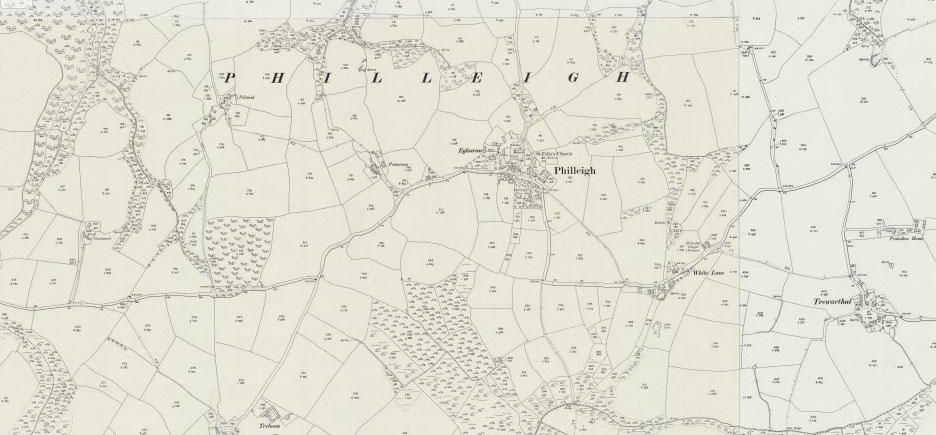
Philleigh is a civil parish and village on the Roseland Peninsula. This profile of Gerrans Wesleyan Chapels has been compiled by Nev Meek of St Gerrans and Portscatho Old Cornwall Society.
Kowethas Kernow Goth – Gerens ha Porthskathow
Introduction
The history of the Wesleyan chapels in Philleigh Parish is not entirely sequential. Initially there was a Wesleyan Meeting at Couches in the east of the parish, then there was the chapel at Treworlas toward the west of the parish which for many years existed in parallel with Lemon Chapel situated more centrally at Eglosrose. Eventually the two chapels were amalgamated into one larger and improved chapel at White Lane.
Couche’s Wesleyan Meeting
In the 1782 Elizabeth Tonkin[1] moved from Gwinear to Feock, where she invited preachers to preach and became a lay preacher herself. She visited Roseland and was “shocked at its godlessness.” In about 1784 she arranged for William Butterfield, an itinerant preacher, to preach at Philleigh. Premises were found for the service but had to be withdrawn at the last minute, “for fear of consequences,” and he consequently preached in the open air. ([1] Elizabeth Tonkin married Thomas Collett in 1785. The couple moved to Veryan where they worshipped at Trewartha.)
(Some landlords objected to nonconformist activity, and in some cases were known to evict tenants who made their houses available for services.)
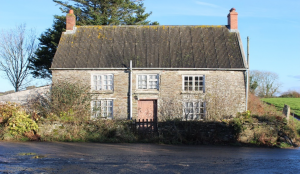 Figure 1 2020 Possible location of Meeting Room at Couches © St Gerrans & Porthscatho OCS
Figure 1 2020 Possible location of Meeting Room at Couches © St Gerrans & Porthscatho OCS
It has been suggested that this initial society was based at Couches; being on the main road from Tregony to King Harry Passage, and conveniently located for travel from Feock. These early societies often met in dwelling houses, and sometimes rooms were set aside in which their services and meetings were held.
Today there is just one cottage at Couches, however an advertisement from 1820, suggests that at one time the tenement was more extensive: –
Royal Cornwall Gazette – Saturday 30 September 1820
TO BE SOLD
By Public Auction,
At the House of Mrs. Russel, in Philleigh Church-Town, on TUESDAY, the 10th day of October next, by Three o’clock in the Afternoon, all that TENEMENT and PREMISES, called
COUCH’S OR STROU’S
Situate in the Parish of Philleigh aforesaid; Consisting of a substantial stone-built Dwelling-House, a Cottage, all convenient Out-houses, and about five Acres of exceeding good Meadow land, on a Lease from Lord Falmouth, for a term of Years, determinable on the Deaths of three good healthy Lives, with liberty of reversion.
Further particulars may be known by application to Mr. JAMES BENNETT, Tregony, and at the day of sale.
N.B. The Premises are in a most delightful country, within a short distance of Truro, Tregony, St. Mawes, &c. September 27, 1820
Older maps also show that originally there were other premises at Couches, situated further west, along the road toward the junction with the King Harry road:
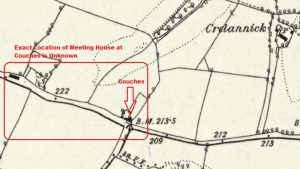 Figure 2 1888 O.S. Six Inch Map
Figure 2 1888 O.S. Six Inch Map
In 1821 an Episcopal Visitation mentioned that two unlicenced rooms were being used in Philleigh parish for the purpose of non-conformist religious services. One of these rooms is likely to be at that at Couches. (The location of the second room is unknown; it has been suggested that it may have been at Eglosrose.)
In 1832 and 1837 the Circuit accounts include a class at Couches, initially with 5 members. It is this record that suggests that the society was based at Couches. In 1853 it was recorded that weekly Sunday services were held at 1800hrs. In September 1865 the members transferred to Lemon Chapel, situated closer to Philleigh Churchtown.
Treworlas Wesleyan Chapel
In 1814 this chapel was built at Treworlas at a cost of £250 and was constructed of stone and cob. It is described as a “simple vernacular example;” it was built with a half-hipped roof and distinctive bulls-eye windows in the north gable. There was a staircase on the interior fixed against the north wall, leading to a raised position or pulpit from which the preacher delivered their sermon, to the congregation seated at the southern end. Initially the chapel was privately owned.
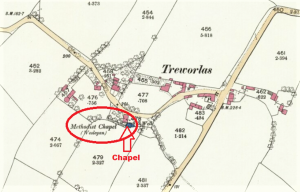 Figure 1 1880 O.S. 25 Inch Map
Figure 1 1880 O.S. 25 Inch Map
In 1818 weekly services were held at 1800hrs. On 9th March 1820 the chapel was licenced when it was referred to as “a house belonging to Samuel Thomas in the village of Treworlas.”
In 1821 an Episcopal Visitation recorded that there was a licenced non-conformist meeting house in Philleigh Parish, which is evidently referring to Treworlas Chapel. The chapel was served by 3 licenced preachers and several unlicenced preachers, none of whom lived in Philleigh.
At some point a small building was built to the rear of the nearby Treworlas House. The building was equipped with a chimney and a fireplace in the 1st floor room. It is known locally that this was built for the circuit minister to stay when he came to preach at Treworlas.
In 1826 the membership of Treworlas was 25, when the Wesleyan chapels in Roseland were transferred into their own St Mawes Circuit. In 1843 the congregation of the chapel contributed 15 signatures objecting to the introduction of the Factory Education Bill to Parliament, which proposed more Church of England influence in schools.
John Withiel was born in about 1742, and in about 1790 was converted to Methodism. When he died in 1830 at Treworlas he was one of the oldest Methodists in the Circuit.
In 1845 the Treworlas Chapel was in regular use and on the 25th December was the location of the quarterly circuit meeting. In succeeding years, it continued to be a venue for these quarterly meetings, which were often reported on in the newspapers.
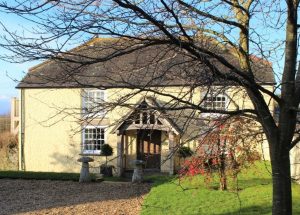 Figure 2 2020 Former Treworlas Wesleyan Chapel © St Gerrans & Porthscatho OCS
Figure 2 2020 Former Treworlas Wesleyan Chapel © St Gerrans & Porthscatho OCS
Richard Martyn was a leading Methodist, who relocated from St Mabyn to Treworlas in retirement. The Reverend William Billing from Portscatho came to live with Richard at Treworlas for a period prior to his death in 1839. Richard himself died in 1850 and a memorial to him was placed in Treworlas Chapel. The newspaper reported on his death:
Royal Cornwall Gazette – Friday 20 September 1850
On Sunday evening last, Mr. Richard Martyn, a respectable farmer of Treworlas, in the parish of Philleigh, about 60 years old, preached at the Wesleyan Meeting house at Trewartha, about two miles from his home. He returned thence apparently in his usual good health. About 9 o’clock he was taken ill, and before 10, he was dead.
Treworlas was an important early chapel in the Roseland and regular Sunday morning and evening services were held right up to its closure. The various religious events and chapel anniversaries were all regularly celebrated, and reported on in the newspapers. For example:
Royal Cornwall Gazette – Saturday 26 July 1873
TREWORLAS – Wesleyan Sunday School
The anniversary was recently held, and two sermons were preached by Mr Lampshire, of Grampound. On the following day the children were examined by Mr Parsons and passed very creditably, and afterwards had tea. The teachers and friends subsequently partook of tea. Addresses were delivered in the evening, and there was come very good singing, Miss Cregoe ably presiding at the harmonium.
There was a second chapel in Philleigh Parish, Lemon Chapel. In March 1882 it was decided to build a new chapel at Philleigh and combine the two existing congregations. In June 1882 the Chapel Committee decided that Treworlas Chapel would be sold. In 1883 the new chapel was built at White Lane, and Treworlas Chapel closed with the congregation transferred to the new chapel, as planned. At the time of closure, Treworlas had just 2 members.
Over the ensuing century the former chapel was used as a farm building and by the 1980s had fallen into a poor state of repair, there was no ceiling inside and no original features such a ceiling roses or plaster cornices. All of the woodwork had long since been removed. There was a mark in one wall where a memorial may have been previously fixed. There was a large hole in the front wall with a galvanise door. The building was being used to store an old David Brown tractor.
Between 1990 and 2000 it was sold to a local person, and converted into a dwelling.
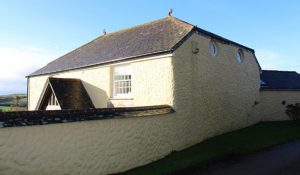 Figure 3 2020 Former Treworlas Chapel showing Bulls-eye Windows in Gable End © St Gerrans & Porthscatho OCS
Figure 3 2020 Former Treworlas Chapel showing Bulls-eye Windows in Gable End © St Gerrans & Porthscatho OCS
Lemon Chapel
In 1821 an Episcopal Visitation mentioned “two rooms not licenced” as well as “one licenced Meeting house” at Philleigh. It has been suggested that one of the unlicenced rooms would have been at Eglosrose, a precursor to Lemon Chapel, built a few years later
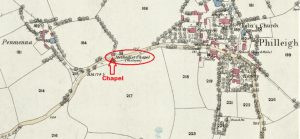 Figure 1 1880 O S 25 inch map
Figure 1 1880 O S 25 inch map
On 28th September 1838 land was leased by Sir Charles Lemon of Carclew for the purpose of building a Wesleyan Chapel at Eglosrose. Lessees were: –
(The datestone in the centre of the south wall reads “W.C. 1838”.)

The lease was for 3 lives, and rent was £2.1.0 a quarter.
The full description of the plot on the lease was, “a plot of ground on the right-hand side of the road from Philleigh church to King Harry’s Passage, adjoining a field, part of Eglos Rose, the land to be used to erect a chapel for the use of the people called Wesleyan Methodists.”
Globe – Wednesday 16 January 1839
NEW CHURCHES AND CHAPELS
A new Wesleyan Methodist chapel just opened for divine service at Philleigh, Cornwall.
On 22nd February 1839 the land for the chapel was purchased for £80, the above-mentioned lessees, being the trustees. There were 12 members of the Society at that time, which increased to 17 by 1841.
In 1843 the Home Secretary introduced a Factory Education Bill to Parliament. It proposed the creation of schools for factory children. However, the point of controversy was that the Bill proposed to make the education Anglican instruction, under the control of the Church of England. Understandably dissenters were outraged and protest meetings were held across England, and presumably Cornwall. Petitions were organised opposing the Bill, and subsequently presented to parliament with a total of 2,069,058 signatures. This included 30 signatures from the congregation of Lemon Wesleyan Methodist Chapel.
In 1861 a Wesleyan Chapel was recorded on the census for Philleigh, but it could refer to either Lemon Chapel or Treworlas Chapel. In 1861 the Society at Lemon Chapel had just 7 members. Sunday afternoon services were held at the chapel on a weekly basis, until 1881 when an evening services was added.
On 7th June 1882 the Chapel Committee decided to sell Lemon Chapel, it having been decided in the March to build a new chapel. The Society members numbered 21 by that time. In 1883 the new chapel was built at White Lane. Lemon Chapel closed and the congregation transferred to the new chapel, the Society number having reduced slightly to 17. The chapel was converted into 2 cottages, now referred to as Lemon Cottages.
Subsequently, the building has been much extended. The two chimney stacks on the current building mark the east and west gables of the original chapel. In about 1980 both cottages were extended laterally by roughly 50%. The easternmost cottage has recently been extended further. As of 2020 the building was in good structural and decorative repair, both cottages were occupied as primary residences.
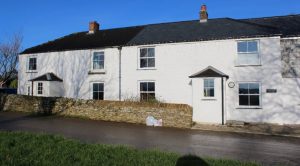 Figure 2 2020 Former Lemon Chapel © St Gerrans & Porthscatho OCS
Figure 2 2020 Former Lemon Chapel © St Gerrans & Porthscatho OCS
White Lane Chapel
Probably by 1881, or at least early 1882 it was decided to close the two existing Wesleyan chapels in Philleigh and combine the congregations into a new larger chapel and schoolroom to be built at White Lane.
On 9th February 1882 a bazaar in aid of the new chapel was held at Polsue. It was opened by the Mayor of Truro, and included a luncheon, music, and speeches. About £120 was raised toward the new chapel. In March 1882 at the Quarterly Circuit Meeting, the final go ahead was given to build the new chapel and separate school at Philleigh, at an estimated cost of £500. In May 1882 the Wesleyan District Meeting, at St Austell, gave permission for the new chapel to be built at an estimated cost of £600.
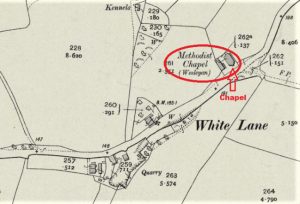 Figure 1 1907 O S Map showing White Lane Chapel
Figure 1 1907 O S Map showing White Lane Chapel
The building plot for the chapel at White Lane, as well as stone from a nearby quarry was provided by Colonel Tremayne. The plans were prepared by W. Swift, Esq., an architect with Messrs, Henderson and Sons, Truro. The plans for the new chapel and schoolroom were for a neat Gothic building of modern design, constructed with local stone, a combination of granite and white pressed bricks being used for the dressings to windows. The internal dimensions of the chapel were 40ft. by 25ft., exclusive of recessed rostrum 15ft. by 5ft., and accommodated 150 worshippers. The internal fittings were executed in pitch-pine, the roof open to collar beam, and the exposed timbers stained and varnished. The windows throughout were glazed with rolled cathedral tinted glass, and ample provision made for ventilation. The schoolroom, a detached building, was 40ft, by 16ft., internally divided by folding partitions to form class-rooms, underneath, with which is provided kitchen-boiler, and ample accommodation for horses and carriages, and other conveniences. Mr. W.H. Welsh of Truro was contracted to build the chapel at a cost of £675.
On 3rd August 1882 the foundation stone for the new chapel was laid by Alderman J. Martin of Truro, and Mr. James Hocking of Ardevora. A total of £103.17.06 was laid upon the stone toward the building costs; a public tea event at Polsue raised a further £110. The building work continued through the Autumn and Winter of 1882.
On 16th February 1883 the White Lane Chapel was registered. the total cost of the building work was £1,000. At that time the society numbered 19.
Over subsequent years the normal chapel life continued with weekly Sunday services held at 1100hrs and 1800hrs. Anniversaries were celebrated and quarterly circuit meetings held. The following newspaper article is typical:
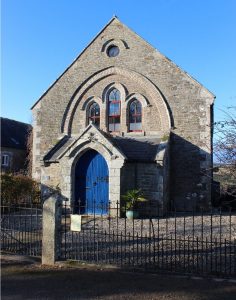 Figure 2 2020 Former White Lane Wesleyan Chapel © St Gerrans & Porthscatho OCS
Figure 2 2020 Former White Lane Wesleyan Chapel © St Gerrans & Porthscatho OCS
Lake’s Falmouth Packet and Cornwall Advertiser – Saturday 03 July 1886
The St Mawes band made their first appearance at Philleigh on Monday, when they were engaged by the Wesleyan body to play on the occasion of their anniversary tea, which was carried out to the entire satisfaction of the leading members of that society. At the close the band were accorded a hearty vote of thanks, many speaking in eulogistic terms of their efficient amateur playing. The band has been formed by a few energetic young men in Mawes, the principal inhabitants having assisted them in their scheme.
By 1888 the membership of the society had risen to 48. In May 1896 White Lane Chapel was authorised to carry out marriages. Over subsequent years the congregation worked hard to pay off the debt on the chapel which was finally paid off in 1906:
Portsmouth Evening News – Monday 15 October 1906
DRAMATIC EFFECT IN A CHAPEL
A dramatic scene has taken place in the Wesleyan Chapel at Philleigh, near Falmouth. The sum of £75 having been raised by the congregation to cancel a note of hand for debt, two lads at a harvest festival held a dish containing the note, while a third set fire to it. When it was reduced to ashes the congregation sang “Praise God from Whom all blessings flow.”
In 1911 there were 37 members of the society. The following newspaper article is typical of events held at the chapel in this period:
West Briton and Cornwall Advertiser – Thursday 04 July 1912
ROSELAND and DISTRICT – Philleigh Wesleyans
The anniversary services of Philleigh Wesleyan Sunday School were held on Sunday and Monday. On the former day Mr. A. J. Lanyon (St. Austell) preached morning and evening, and the scholars and choir sang special hymns to the organ accompaniments of Miss Jenkin. On Monday afternoon the school children assembled and headed by Tregony Brass Band, marched round village and then a field lent by Mr. H. Little, where a programme of games was arranged. The children’s and public tea were served in the schoolroom by the Misses Collett, Jenkin, Cowell, L. Osborne, Venton and M. Dingle. Subsequently, an open-air meeting, held in Mr. H. Little’s field was presided over by Mr. R. Pill (Veryan) and addressed by the Rev. H. Hill (circuit minister).
It is said that in the period after WW1, the vicar at the parish church was so unpopular that the people of the parish decided not to erect their war memorial at the parish church. Instead, it was erected at the White Lane Chapel.
In 1932 the chapel became Philleigh Methodist Church, and in 1940 the chapel was capable of seating 140 persons. In 1950 the morning service became fortnightly, and after a short period changed to monthly. In 1953 the morning service was done away with, leaving just the 1800hrs service on a weekly basis.
In 1966 the membership of the society had reduced to 16, however, £350 was spent on renovations and on 11th July the chapel was reopened. The Reverend J. Russell Pope, Chairman of the Plymouth & Exeter District preached to a good crowd at the re-opening. In 1969 the evening service became an afternoon service.
In 1979 the chapel closed due to falling numbers, at the conclusion there were 6 members and 6 attendees. These came from just 3 local farming families. The last service was held on 26th August 1979 when Reverend Leslie Hayes preached his last service as Superintendent of the Circuit.
In 1981 the chapel was sold. At that time the war memorial was moved from the chapel into the Churchtown. It was re-erected outside of the lychgate of the parish church.
As of 2003 the building was being used as a dwelling.
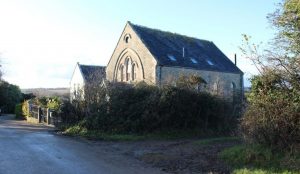 Figure 3 2020 Former White Lane Chapel and Sunday School © St Gerrans & Porthscatho OCS
Figure 3 2020 Former White Lane Chapel and Sunday School © St Gerrans & Porthscatho OCS
Nev Meek (Recorder): nev.meek@sky.com

I live in st austell and every time I pass couch cottage I say I would love to buy it and restore it back to a good condition and live there what a beautiful spot